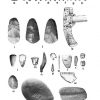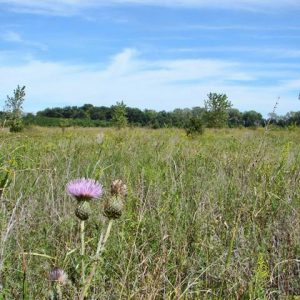calsfoundation@cals.org
Eaker Site
The Eaker Site is a large, prehistoric archaeological site located near Blytheville (Mississippi County) on land that was formerly Eaker Air Force Base. The site is named after the base. The Eaker Site is considered the largest and most intact Late Mississippian Nodena site in the Central Mississippi Valley. The site was declared a National Historic Landmark in 1996 and is on the National Register of Historic Places.
Archaeologists use the term “Nodena” to describe the Native American way of life along the Mississippi River that the Eaker Site represents. The site is believed to have been a Nodena-Phase town, with sturdy permanent houses, a defensive wall and ditch, and a mound.
Native Americans built the structures at the Eaker Site, and some probably built mounds, during three distinct archaeological periods—Late Woodland (Baytown Period), circa AD 600; the Late Mississippian Period, circa AD 1250; and the Late Mississippian Nodena Phase, circa AD 1350–1450. Archaeological evidence indicates that it was during the last period that a large palisaded village, complete with a temple mound and defensive ditch, was constructed.
Dating from about AD 1400 to 1700, the Nodena Phase is characterized by a collection of villages along the Mississippi River. The Eaker Site was one of these villages. Like many Mississippian culture settlements, the Eaker Site was located on the bank of a waterway. Pemiscot Bayou, which was a major waterway in earlier times, is located in the St. Francis Basin of the Mississippi River Valley. The Eaker Site is large but has no known mound, although it might have once had one.
Nodena people also had a widespread trade network, bringing whelk shells (sea snails), chert (a form of microcrystalline quartz used for arrow and spear points), basalt, and other exotic goods to the area. Historians believe that Spanish explorer Hernando de Soto may have visited the Nodena villages in the early 1540s, so it is possible that he visited the Eaker Site because of its size and importance as a Nodena complex.
In the late eighteenth and early nineteenth centuries, select harvesting of lumber began on the Eaker Site. By the mid-1800s, farmers began to systematically clear the Eaker Site of trees and swamps for land cultivation. During this early period of cultivation, whatever mounds existed at the Eaker Site are thought to have been destroyed. In 1942, the U.S. Army Air Corps acquired a large tract of land, including the Eaker Site, for military purposes. However, the area continued as an open agricultural field until sometime after 1982, when Jimmy McNeil of the Memphis District of the U.S. Army Corps of Engineers suggested that the site be removed from cultivation in order to preserve any remaining archaeological items.
In 1988, Mid Continental Research Associates of Arkansas, which wrote the final report, conducted a large archaeology survey of the Eaker Site. Western Wyoming Community College, a minor subcontractor for the venture, conducted a series of test excavations and archaeological surveys of the Eaker Site using a proton magnetometer. Proton magnetometers measure residual magnetism in soil, allowing archaeologists to identify soil anomalies caused by manmade features without disturbing the soil or damaging any of the features. Survey mapping of just 5.5% of the Eaker Site identified eighty underground, manmade anomalies. Later soil testing identified these anomalies as the buried clay floors of houses and palisade trenches as well as the edges of the Nodena-phase mound that had been built on the site. Based on the magnetometer results, archaeologists estimate that as many as 400 or more prehistoric homes may be buried at the Eaker Site.
These cultural features will allow archaeologists to study the nature of Nodena Mississippian towns, as well as the impact of earthquakes on the archaeological records of these towns.
In the twenty-first century, the Eaker Site is owned by the City of Blytheville. The Arkansas Archeological Survey has a regional office in Blytheville, and has, through a cooperative arrangement, carried out excavations at the Eaker Site. The results of these excavations, when published, should improve the public understanding of the Eaker Site and the Nodena Mississippian people who inhabited it. The Eaker Site was placed on the National Register of Historic Places in 1992.
For additional information:
“Eaker Site.” National Register of Historic Places nomination form. On file at Arkansas Historic Preservation Program, Little Rock, Arkansas. Online at https://www.arkansasheritage.com/arkansas-historic-preservation-program (accessed February 28, 2025).
Morse, Dan F., and Phyllis A. Morse. The Archaeology of the Central Mississippi Valley. New York: Academic Press, 1983.
Wadleigh, Linda, and Kevin W. Thompson. Proton Magnetometer Survey of Site 3MS105, Eaker Air Force Base, Arkansas. Proton Magnetometer Report No. 1. Rock Springs: Western Wyoming College, 1989.
Larry LeMasters
LeMasters’ Antique News Service


 Eaker Site
Eaker Site 



Comments
No comments on this entry yet.